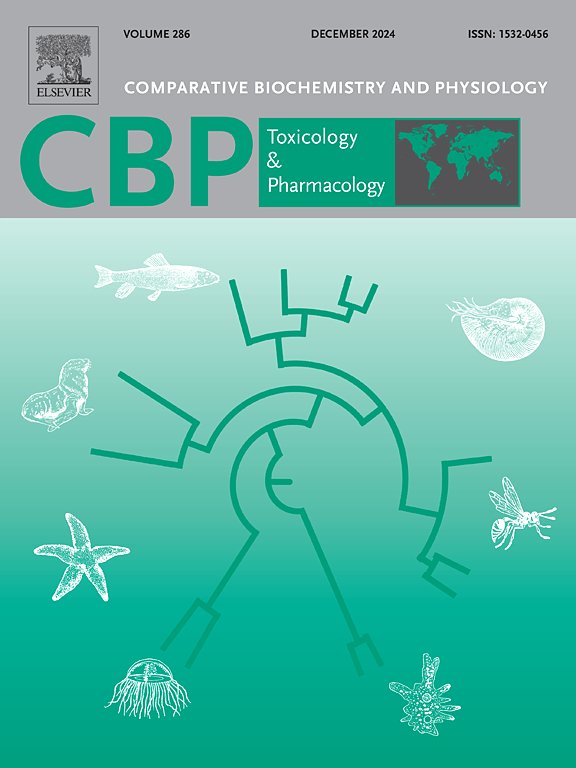Interactions of a PFOS/sodium nitrite mixture in Chinese mitten crab (Eriocheir sinensis): Impacts on survival, growth, behavior, energy metabolism and hepatopancreas transcriptome
IF 3.9
3区 环境科学与生态学
Q2 BIOCHEMISTRY & MOLECULAR BIOLOGY
Comparative Biochemistry and Physiology C-toxicology & Pharmacology
Pub Date : 2024-12-20
DOI:10.1016/j.cbpc.2024.110114
引用次数: 0
Abstract
Perfluorooctanesulfonic acid (PFOS) and sodium nitrite may have complex adverse effects on aquatic animals. This study assessed the interactive effects of PFOS and sodium nitrite on Chinese mitten crab (Eriocheir sinensis). A 2 × 3 factorial experiment with 0, 0.1, and 5 mg/L PFOS and 0, 3.50 mg/L sodium nitrite evaluated impacts on growth, behavior, oxygen consumption, health, energy metabolism, and hepatopancreas transcriptome. PFOS <0.1 mg/L with 3.50 mg/L nitrite significantly decreased PFOS accumulation in the hepatopancreas and improved feeding rates and hepatopancreas structure (P < 0.05). Under 5 mg/L PFOS and nitrite, survival, weight gain, hepatosomatic index, and feeding rate significantly decreased (P < 0.05). PFOS (0.1 mg/L) with nitrite significantly prolonged righting response time and increased locomotion speed (P < 0.05). PFOS (5 mg/L) significantly decreased serum triglyceride and lactate levels, while PFOS and nitrite decreased glucose, triglyceride, and glycogen levels and increased lactate in hepatopancreas (P < 0.05). Transcriptomic analysis indicated that PFOS affects p53 signaling, cell cycle and neurotransmission pathways, with notable changes in cell proliferation genes (pcna, ccna, cdk1, cdk2, rbx1) primarily downregulated by PFOS. Overall, PFOS disrupts neurotransmitter regulation and causes hepatopancreatic damage, while nitrite can reduce the toxicity of PFOS by decreasing its hepatopancreas accumulation. However, high levels of PFOS combined with sodium nitrite exacerbate toxicity, emphasizing the need for comprehensive assessment of environmental pollutant interactions.

全氟辛烷磺酸/亚硝酸钠混合物在中华绒螯蟹体内的相互作用:对生存、生长、行为、能量代谢和肝胰腺转录组的影响
全氟辛烷磺酸(PFOS)和亚硝酸钠可能对水生动物产生复杂的不利影响。本研究评价了全氟辛烷磺酸和亚硝酸钠对中华绒螯蟹的交互作用。0、0.1、5 mg/L全氟辛烷磺酸和0、3.50 mg/L亚硝酸钠对生长、行为、耗氧量、健康、能量代谢和肝胰脏转录组的影响进行了2 × 3因子实验。卵圆孔未闭
本文章由计算机程序翻译,如有差异,请以英文原文为准。
求助全文
约1分钟内获得全文
求助全文
来源期刊
CiteScore
7.50
自引率
5.10%
发文量
206
审稿时长
30 days
期刊介绍:
Part C: Toxicology and Pharmacology. This journal is concerned with chemical and drug action at different levels of organization, biotransformation of xenobiotics, mechanisms of toxicity, including reactive oxygen species and carcinogenesis, endocrine disruptors, natural products chemistry, and signal transduction with a molecular approach to these fields.

 求助内容:
求助内容: 应助结果提醒方式:
应助结果提醒方式:


